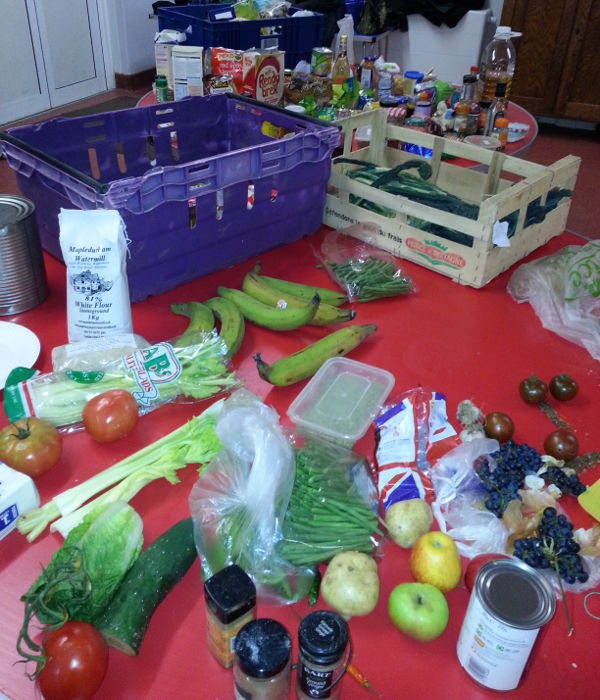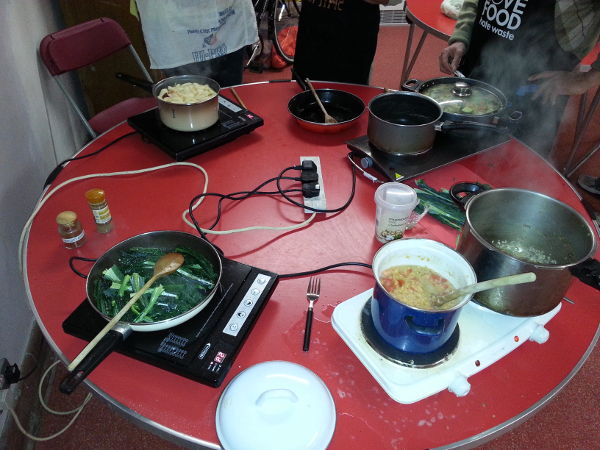Dinnertime at the Food Bank
If I were a despised broadsheet journalist, I'd probably write a really insensitive article about all the fab finds you can pick up for free at your local food bank. I'd write about how very jolly it is, top tips for bagging the best stuff, and promptly get a load of angry Twitter messages sent to me - along with a gazillion page views.
I'm not that person. So here's my middle-class experience of a food bank (by proxy).
Liz and I have recently moved to Oxford and - as part of the process of making new friends - are going to every community event we can manage. We've joined the local environmental group, been on a local litter pick, and attended our first DinnerTime
DinnerTime is a new form of community kitchen. The basic idea is simple.
- Get a large room.
- Supply cooking equipment.
- People bring food.
- People cook dinner for each other.
It's a great way to reduce waste, try new dishes, save money, and meet new people.
Some people bought tins from their cupboard, others fruit and veg that they'd grown. The organisers brought food from a local food bank.
 This immediately caused me to have an attack of middle class guilt. I don't need a food handout. Am I literally stealing food from the mouths of the hungry?
This immediately caused me to have an attack of middle class guilt. I don't need a food handout. Am I literally stealing food from the mouths of the hungry?
The organisers reassured us that this wasn't the case. All the food which we'd got was due to be destroyed that day. Most had hit its use-by date. Some - like the kale - was very grimy and quite hard to prepare unless you've experienced it before. Others - like the frozen garlic - just wasn't able to be made use of by the people who go to food banks.
So, along with the spices and herbs we'd provided, we started the mass cook!
 All of the cooking utensils and hot plates had been recycled - either donated, or rescued from the rubbish dump. There were about 30 of us in all, happily chatting, cooking, swapping recipes.
All of the cooking utensils and hot plates had been recycled - either donated, or rescued from the rubbish dump. There were about 30 of us in all, happily chatting, cooking, swapping recipes.
In a weird sort of way, it was like the Great British Bake Off - we'd been given ingredients and were told "impress each other". Let me tell you - it's hard to impress people with Kale! But there were risottos, curries, salads, fruit pies, and all sorts of other tasty treats by the end of the evening.

The meal was amazing! One of DinnerTime's policies is that all donations should be vegetarian - so I was able to munch on everything :-)
Some people had brought in dishes they'd made at home, there were a couple of bottles of wine (not from the food bank), and - surprisingly - everyone helped with the washing up!
After all the dishes were cleaned, we got some takeaway cartons and started scooping up leftovers for tomorrow's lunch. There was only one problem - there were still a lot of ingredients left. We were encouraged to take them home. That's when my other surge of guilt occurred. As I carried home a couple of kilos of wilting kale, some freezable garlic, and a half-dozen bits of assorted fruit (bruised, but good enough for a pie), I couldn't help but wonder if this was the best use of food.
Without a doubt, a whole group of us pooled resources and made use of food which couldn't otherwise be given away or used. And, in coming together, we were able to make dishes which we couldn't have done as individuals. Because I have a freezer which I can afford to run, and I have sufficiently well stocked cupboards with a range of ingredients, I can eke out more nutrition out of food which would otherwise have gone to waste.
I've been enjoying Jack Monroe's blog about how to cook on a budget. I wonder if one way to stretch a food budget is to encourage more community kitchens? Or even just cooking with neighbours? Of course, this relies on you knowing and liking your neighbours and ensuring that everyone contributes fairly. Surely it's cheaper to boil pasta for a group of five people than it is to boil five separate saucepans? No one wants to eat a whole head of lettuce that's nearing the end of its life, but it can be turned into a salad for a group to share.
It's not a permanent fix, and it doesn't address the underlying issues of food and energy poverty - but it is a great way to meet people, share food, and reduce your bills.
If you're interested in setting up a DinnerTime, you can download the DinnerTime Handbook for free.

One thought on “Dinnertime at the Food Bank”